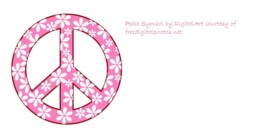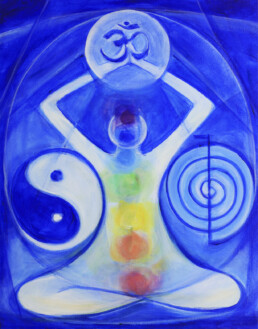Peace, Love, and Crime: Transcendental Meditation and the Maharishi Effect
For quite a long time now, I've been interested in the effects of distant healing and the ability of people to impact consciousness for the greater good. In my therapy practice in Bryn Mawr, I often can feel the energy shift as clients are making changes. But can we make changes beyond the therapy room? Is what I'm feeling real? I think it is, and that we can, based on what I have read about meditation and the Maharishi effect.
The 1% effect. (No, not that 1%)
One of the most fascinating studies of the impact of group consciousness on the greater whole is the Maharishi Effect. Back in the 1970s, Maharishi Mahesh Yogi, developer of Transcendental Yoga and guru to the stars, predicted that if 1% of a population performed Transcendental Meditation (TM), they would produce measurable improvements in the overall quality of life for the entire population. His students began to track the data, and in 1976 published a paper that found a 16% reduction in crime when 1% of the population participated in TM.
If isolated TM practitioners could have such an effect, they wondered, what would be the impact of a group meditating together? Researchers predicted that the coherence generated by a group of TM practitioners working together could impact a group the size of the square of the number of meditators. In other words, two people meditating together could impact a group of four; 100 meditators could impact 10,000; and 1,600 could impact 256 million people― the population of the US at that time.
And so they set out to test their hypothesis, collecting FBI crime data in the US, and other data from around the world, when large TM groups met. Statisticians carefully controlled for other variables, and the findings are remarkable.
Here are some of the highlights (and here's a link to my primary source):
- 1980-1981, crime in Delhi decreased by 11% during a TM convention
- 1984-1985, crime in Manila decreased by 12.5% during a TM convention
- 1981-1983, Maharishi University opened a campus in DC; violent crime decreased.
- 1983, a group of meditators met in Jerusalem; crime in Jerusalem decreased 7.4%; crime in Israel decreased 4.1%.
- The war in Lebanon was also affected, with a decrease in war death and war intensity.
- 1993, violent crimes decreased during a TM convention in DC and politics functioned better―enough to make a reporter remark, "such a swift reversal of political fortunes is not easy to account for".
- 1979-1985, when the group of meditators at Maharishi University in Iowa numbered more than square root of 1% of US population, there was a decrease in violent deaths in the US.
- TM group participation in Iowa also affected quality of life in Canada, with a marked decrease in violent deaths, cigarette consumption and worker strikes.
Can we start to take advantage of this? Please?
The data are impactful, and I was left wondering ―why did it take me 20 years to hear about it? Why haven't we capitalized on this effect? And―can we start now? Last summer I held a group meditation on 8/8, the "Lion's Gate", as part of the worldwide synchronized meditation for peace. I think that when enough people tune in, we will make a difference in the world. I'm already marking my calendar for this year's International Day of Peace, 9/21/2015―and I hope you do, too.
I suspect that it is not TM alone, but any practice that brings people to a calm, heart-centered, spiritual state that can have such an impact. And I intend to find out!
I goofed ―and it turns out, I grew
In addition to my work as a therapist and healer, I am a yoga teacher --and I love it. Being a part of the yoga community is rewarding, being a teacher is an honor. Finding the right time-slot for a class is both art and science, as we try to figure out when people can, and want to, come to class. Two weeks ago I spoke with the owner of the studio where I teach, and we decided to start my class 15 minutes earlier. I think this is a fantastic idea: it will bring more students to the class; it will make my day end a little earlier. The new time was to begin yesterday. The problem is, I forgot. En route to the studio, I realized my mistake. Instead of being ten minutes early, I was going to be five minutes late.
And then, a miracle happened: I didn't beat myself up.
I spoke with the studio owner, who was on site as she had just finished teaching. She was gracious and handled the situation with a problem-solver's good humor. She said she'd start the class, and I could take over when I got there. Her grace made it easier for me to hold mine. That is huge. That is HUGE. That is something we can all learn from. We can make the world a safer, happier place by choosing to panic less and to be calm and kind.
According to the Dalai Lama, the purpose of life is to be happy. It is difficult to be happy when we are caught in a constant barrage of criticism, especially that sneaky and pervasive self-criticism. Giving others grace is profound. Giving ourselves the same grace that we would grant another is life-changing. We are going to make mistakes; we are human. How we respond to those mistakes can determine our overall happiness. It can take us closer to, or move us away from, the very purpose of our lives.
I have a history of deep, pervasive, acerbic self-criticism. But I have been really working on this stuff since 2002. I have an arsenal of effective and well-honed techniques that have helped me: hypnotherapy; EFT and other Energy Psychology techniques; Reiki and other energy healing; an almost-daily meditation practice. (Note this is a meditation practice, not a perfect. I have yet to achieve samadhi. I barely find pratyahara. It's all good.)
I've also grown older, and at 46, I'm not the same gal I was at 33. My dad, known for his character and wisdom, once assured me that "these [crises] have a way of working themselves out". Crises do pass, and while they are with us, they teach us a lot. Sometimes I think of my Higher Self speaking to me like a light-hearted Mafioso, saying "We can do this the easy way, or we can do it the hard way…." Let's do the easy way, please.
Yesterday's mistake showed me how far I have come. I would like to take this opportunity to congratulate Sarah. Good job yesterday! Congratulations on not freaking out or beating yourself up. And please, keep up the good work―life is much happier that way.
:)
The role of emotions in cancer
Susie (name changed for privacy) came in to my therapy practice in Bryn Mawr, and she was reeling. She had been diagnosed with breast cancer and treatment was underway. But she wasn't sleeping. She was trying to keep it all together, and ended up alternating between tears and anger. She was certainly having trouble engaging in life. And she knew that none of that was helping her condition. So much was beyond her control, but she could benefit from understanding the role of emotions in cancer.
The role of emotions in cancer
The mind-body connection has major implications for our health and well-being. People all across the Western world are taking up practices like mindfulness, meditation, and yoga, and they are doing it with good reason. They feel better, and there is a deep and growing body of empirical evidence showing that emotions play an important role in health.
Resources as mainstream as WebMD and the Mayo Clinic address the role of stress in health. We know that stress and traumatic events impact the hormonal stress response system in ways that impair immune function and can lead to disease―even cancer. And we know that there are ways to combat that impact and improve overall health and wellbeing.
In one study of 94 women with metastatic or recurrent breast cancer, stress was correlated to disease: women who had not experienced significant stressors remained disease-free for longer periods of time than those who did experience significant stress.
So, what are you supposed to do if you are upset?
There is good news even for people experiencing tough times. You can fare better if you deal with your emotions. According to David Spiegel, M.D., one of the study authors, "people do better in the aftermath of traumatic stress if they deal with it directly. Facing, rather than fleeing it, is important... In other words, don't suppress your emotions."
Please, don't suppress your emotions. Many people who have been diagnosed with cancer experienced a significant loss in the two years before diagnosis. I can't tell you how many times when I'm doing energy healing on a person with cancer I hear the phrase "un-cried tears ". Tears are not shameful, and we should throw away the silly lyric "big girls don't cry" and its implication that even little boys shouldn't. Tears are cleansing and we do ourselves a great service when we cry them.
The "Type C" personality
Not shedding those tears is an aspect of the "type C personality", a term dubbed for the traits commonly seen among people who have been diagnosed with cancer. In the Cancer Report, Susan Silberstein, Ph.D., of the Center for Advancement in Cancer Education, outlines the traits. They are:
- Repression of negative emotions (as mentioned above)
- Feeling hopeless, that there are no options, or a lack of control
- Not having deep emotional ties or being in toxic relationships
- A tendency to keep the peace at any cost, to put others' needs first, or even to be unaware of their own needs
- A feeling (often unconscious) that they do not deserve happiness, success, or even life
- A need to gain attention through the disease which they could not, or did not, receive otherwise
No, it's not your fault
Getting cancer is not anyone's fault. We are living at the intersection of genetics, experience, environmental toxins. A lot of that is beyond our control, which can feel scary. But some of it is, and that's why this information about the mind-body connection and the "Type C personality" can be so empowering.
When I work with clients who have cancer, we spend a lot of time re-working their emotional patterns. We create a safe space to cry. We reframe the work ethic to create less stress and a more balanced life. We practice shifting emotional boundaries to create healthier relationships. We shine the light on those tendencies to "stuff it" and practice speaking up. All of these are skills that can be learned, and learning them leads to a happier, and healthier, life.
As for Susie...
Susie and I worked together for several weeks. During that time she had a few "aha" moments. On her first visit, she cried. But after the tears were released, she started to feel lighter and clearer, and certainly more optimistic. We used some hypnotherapy and guided meditation techniques to help her find her voice. When she used it, she found that, far from driving people away, her relationships actually improved. She evaluated her work schedule and found ways to be more efficient and less stressed. And she became confident that her treatments were working. Susie managed to learn some of the lessons her cancer had to teach and was able to get back to the joy of living.
And that, it seems to me, is pretty much the point. :)
My life is giving birth to me
Being born is not a comfortable process. I often feel that my life is "giving birth" to me. This is a metaphor that often comes to mind when I'm working with my clients in my therapy practice in Bryn Mawr.
There are moments of comfort, certainly. But there are unavoidable moments of painful growth, when I am squeezed and pushed and molded into something new. Painful experience seems to be part of the human condition. We are told that humanity as a whole is progressing under the 4th Ray of Divinity, the Ray of harmony through conflict. That theory is hard to argue with.
Our painful experiences, though, are turning us into something more useful and pure. Pain is the heat applied in the crucible of our existence. When we hold this in our minds, it makes the pain a little easier to bear. When we are able to detach a little from the pain, we can navigate it a little better. One way I've found to be a little more detached is to remember that each of us is made up of many parts, physical, emotional, mental, and spiritual.
Our bodies are made up of 50 trillion cells, and each of those cells is a little unit of consciousness. Bruce Lipton, in the fabulous Biology of Belief, describes the movement of cells in a lab setting: In a Petri dish, human cells will move toward a sugar source and away from a poison. They have consciousness, of course on a different scale than ours, but consciousness nonetheless. Imagine how they respond to the thoughts we send to them…imagine how they will respond to kinder thoughts.
Our emotions exist on a different level of consciousness than our bodies or our minds. Emotions use different brain structure than thoughts. The limbic system is the emotional brain and the cortex is the "thinking" brain. The limbic system sends more signals up to the cortex than the other way around, which helps explain why emotions can sometimes overwhelm reason. Luckily we can learn to take a more detached position, and when we do, we begin to notice the flow of emotions. We still experience them, but without drowning in them.
Our thoughts are different from our feelings. Our thoughts sometimes run away with us, but with practice we learn to control them. The first step to this control is to witness them. We notice them arise and float away, and begin to realize that we have thoughts, but we are not our thoughts. We have been told that with our thoughts we create the world. As I look back on my own life experiences, it seems that there is some truth to this. But often we create by accident or default because we create the things we are afraid of. With practice we can learn to use our thoughts to create the things that are for our higher good.
The highest level of being that most of us are able to access at times is the level of our Soul, which is who we really are. Instead of identifying with the passing pleasure and pain of our 3-D physical world, we are learning to identify with a higher purpose, a higher level of consciousness. When we contact our soul, we experience pure joy, gratitude, and peace. We become more intuitive and less critical, and realize that when one member of our human family is suffering, we all suffer. We come to understand that we are more than what meets the eye.
I think that is the purpose of our suffering: To teach us to shift our focus upward. Painful experience shows us that we are placing our attention on the temporary and transient rather than the real and transcendent. Holding on to this idea has helped me to witness my suffering on one level, even as I participate in it on another. This eases the pain and opens me up to pure joy. And that is pretty fantastic!
My typo as a metaphor, and it's OK to ask for help
I sent an email newsletter last week and it had a big mistake in it. The second paragraph makes no sense. It says: "Have you ever considered that what we do that with our spaces, we can do that with our energy fields?"
I knew what I meant.
I usually have a second set of eyes proofread for me, but this time I was late getting it sent and was impatient. I read it several times, and read it out loud. Reading my writing aloud is a good way to make sure it makes sense. But this time it didn't work.
The problem was that I knew what I meant to say, so I didn't notice what I actually typed. Knid of lkie you can udnresantd waht tihs syas.
I should have used my proofreader.
Which brings me to the point: We should always use our team!
Humans are social creatures. When we tell ourselves, very stubbornly, "I can do it all by myself" we are likely mistaken. The stubbornness itself is probably a sign that we are mistaken.
Of course there are lots of things we are supposed to do alone, but in the bigger scale, "no man is an island unto himself". We humans thrive in relationships. We are happy in community. We gravitate to groups, try to find our tribe, we work out our issues in relationship with others.
When my little sister was in a high chair and just learning to talk, she wanted to do everything all by herself. One night we were having stir-fry with soy sauce, she was at that age of budding independence and wanted to pour it "all by herself". The over-sauced food made her shudder.
This is what happens to us even as adults when we stubbornly, and I dare say immaturely, decide that we can do "it" ―anything, everything―all by ourselves. We shudder as we learn the hard lessons of ego, and come to realize the beautiful reality of interdependence.
I see many brave and strong clients who mistakenly believe that asking for help in time of crisis is a sign of weakness. I have done this too, but I try to remember what I remind my clients.
Getting help is not a sign of weakness: It is a sign of humanity. Sometimes we find that the best thing we can do is to ask for help, to let others in. When we deny ourselves the help, and deny others the opportunity to be of service, we throw things out of balance.
Sometimes we give, and sometimes we take. Sometimes we lead, and sometimes we follow. But we never travel alone. And when we forget that, we have forgotten the very thing that makes us human.
The Chakras: Foundations of Health
You know you are more than your body, that you are an energy being, timeless and expansive. How does that energy become the "we" that we see? Part of the explanation comes from an understanding of the energy body. Basically, our physical bodies are the concrete reservoir of energy pouring into us from the biofield, the energy body that surrounds and interpenetrates us. Within that biofield are seven major (and many minor) energy centers, or chakras. This blog provides an introduction to the chakras, or the seven major energy centers within a human body.
Chakra is the Sanskrit word for "wheel" and the name is apt, because each of these centers spins, allowing energy to flow in and out of our bodies. The energy centers also correspond to a layer of our biofield. And inside our bodies, they correspond to a gland. Moreover, each chakra relates to some basic physical and emotional issues, both positive and negative. In this introduction to the chakras, we will use the terms "energy centers" and "charkas" interchangeably.
Introduction to the chakras
Energy flows into our system from the crown chakra and circulates through all of the other chakras, into the back and out the front. Energy steps down, layer by layer, as it circulates through the biofield or aura. It eventually makes its way into the etheric sheath, the layer of energy that envelops the physical body. From there, it enters the physical body itself.
Energy is everything, and therefore nothing exists in the physical that doesn’t first exist in the etheric or energy body. The health of our body is directly related to the flow of energy through our etheric body, and the health of the etheric body is directly related to the flow of energy through the six other chakras and their respective layers of the aura. Here's a framework to understand how it all works.
The root center.
The first or root chakra corresponds to the etheric sheath. The root chakra is located just below the perineum. It is associated with the adrenal glands, which are the masters of the “fight or flight” response. Root chakra imbalances, then, often involve either chronic stress or "flightiness.” This shows up as a lack of grounding -- aka, a poor functioning of the root center.
The issues typically associated with the root chakra include survival issues and the will to live, inherited beliefs, some sleep problems, and being grounded. Physical issues can include autoimmune disorders, kidney problems, and issues like chronic fatigue. When the root chakra is fully functioning, we are grounded. We feel fully alive and present in our physical plane lives, and have a sense of belonging here on earth.
The sacral center.
The second or sacral chakra is located at the top or the sacrum, about two inches below the navel. This energy center is related to the astral or emotional body, what we often think of as the inner child. The astral body forms the second layer of the aura. The glands associated with the sacral center are the reproductive glands.
Not surprisingly, then, issues associated with the sacral center include sexual issues, emotionalism, relationships, and even money issues. Physical issues related to the sacral center may include certain digestive complaints and issues related to the reproductive system. This center has a lot to do with relationships, as well as harmony or disharmony. When the sacral center is clear and fully functioning, we will experience emotional equilibrium, peaceful relationships, and an end to victim consciousness.
The solar plexus
The third chakra is the solar plexus center. It is located in the area of the diaphragm. This center is related to the ego or lower mental body which forms the third layer of the aura. In terms of the glands, the solar plexus corresponds to the pancreas.
The issues associated with the solar plexus center include judgments and criticisms, separativeness, and an “us vs. them” mentality. Health issues related to solar plexus dysfunction include diabetes and many digestive complaints. The solar plexus is also the seat of stress, and an overactive solar plexus can drain the heart center. Thus, heart issues often involve the solar plexus. When the solar plexus is fully functioning and clear, our little egos are under control and we are aligned with the Higher Self.
The heart center.
The fourth chakra is the heart center and is located right at the middle of the chest. This energy center connects the energy of the fourth layer of the aura. It corresponds to the thymus gland, which is important in regulating immune function. When the heart chakra is open and fully functioning, we are connected to our Higher Self and open to group consciousness. We embrace and live the understanding that what is good for one is good for all.
Low energy in the heart chakra is analogous to an overactive solar plexus: anger, criticism, and separativeness. Physical heart chakra issues can include immune deficiencies as well as heart and lung issues. Opening the heart chakra includes self-forgiveness, self-love, and releasing past hurts. Again, the third and fourth chakras are directly related to one another. An overactive third drains the fourth, and vice versa. Interestingly, some experts say that the next step forward for humanity is in opening the collective heart center. It is interesting to consider what that will mean for us, isn't it?
The throat center.
The fifth chakra or throat center is located at the base of the throat. It is associated with the thyroid gland which runs our metabolism. This chakra is all about communication: speaking our truth, connecting to our Higher Self, and manifesting. The fifth and second chakras are directly related. This seems reasonable when we consider how emotions affect communication! An overactive sacral center (emotional body) drains the throat center (unable to communicate or connect to the Higher Self).
Unsurprisingly, throat center problems arise when it is over-active (angry outbursts, for example) or under-active (unable to speak up for ourselves). Moreover, when we are not clear about what to do or how to move forward, we can guess there is an imbalance in the throat center. Illnesses associated with the throat center include many thyroid issues and some voice problems. When the throat is fully functioning and open, we can effectively and harmlessly speak the truth. Moreover, we connect to our Higher Self and we can create or manifest.
The ajna center, soon to be your third eye.
The sixth chakra is called the ajna center. It is located at the middle of the forehead. It corresponds to the pituitary body, which runs the endocrine system. When this center is fully open, it functions as the Third Eye, opening our awareness to the Buddhic plane, the center of intuition and the sixth layer of the aura.
For now, the ajna center contains the recapitulation of all the energy from the lower centers. In fact, problems with the entire glandular system may stem from problems with the ajna center. Imbalances in the sixth chakra typically happen when we are too much “in our heads”.
The crown center.
Finally, the seventh or crown chakra is located above the top of the head. Energy pours into our system via the crown chakra and circulates through the other chakras. This chakra is associated with the pineal gland and the seventh layer of the aura.
Problems in the head center may lead to migraines. It connects us with the Monad or Spirit and opens us to what is sometimes called "Christ" or "Krishna" consciousness. Sometimes people refer to this as universal consciousness. For most of us, we can only hope to connect to such high vibrations of love and wisdom! In the meantime, the crown center sows energy into our entire system.
Now, what will you do with your introduction to the chakras?
Now that you have this basic understanding of the chakras, what will you do with your knowledge? If you are intrigued, it may be worth studying a little more! ACEP's upcoming Comprehensive Energy Psychology course will provide you with more information to help you deepen your understanding. To understand how to use the chakras for developing your intuition, read Lori Hops’s blog here. If you are still a little skeptical (or know someone who is), read this report on a study focusing on the evidence for the chakras.
Author bio:
Sarah Murphy, LPC, ACP-EFT, is an ACEP Board member and chair of its communications committee. She has a private practice where she specializes in helping people with serious or chronic illness.
How to Commit to Meditate
We know we "should" meditate--tons of physical, emotional, and mental benefits have been documented. We can lower blood pressure and cardiovascular health, improve outcomes for a host of medical treatments, relieve depression and anxiety, improve concentration and mental function, and more and more...but somehow we just can't seem to commit to the practice. Disciplined in so many other areas, why are we blocked from the discipline of meditation? We know we can benefit from as little as 10 minutes. The questions remains: how to commit to meditate?
Our egos like to be busy and they like to be in control. In order to maintain that (illusion of) control, the ego can set up a lot of road blocks to keep us from meditating. Here are some of the common strategies our egos use and some ways to counter them:
- Our egos love to tell us that we are too busy to meditate. Of course that is not true. There is an old saying that goes: "Meditate every day for an hour unless you are too busy. In that case, meditate for two hours." There is a lot of truth to this, but an ego that thinks it is too busy probably won't agree to that! So we can set an expectation that our ego will agree to. We can achieve a lot in just five to ten minutes of meditation, and even the most stubborn egos will have a hard time arguing with that!
- Our egos often tell us that meditation is something specific that we "can't do". The inner dialogue goes something like "Meditation is not thinking; I can't not-think!" or "Meditation is reciting a weird mantra, and I don't want to do that!", or "Meditation means sitting cross-legged, and my legs can't cross like that!", or "Meditation means counting the breath; I'll feel like I'm suffocating!" Meditation can be any of these things and it can be something else. We can do a little research and find a style that seems reasonable to us.
- Sometimes our egos tell us that we can't meditate because we can't stop thinking. When my ego tried that one, I made a deal with it: I sat in meditation but let my mind process its ideas, go through the list of chores, think about the grocery list. This became "thinking time before meditation". I decided to be OK with it, and have come to think of it as a kind of clearing process. Many of my meditation friends do the same thing. As it turns out, our minds come up with some good stuff when we give them the time to process. After the processing time, we can move on to our meditation.
- In other cases, our ego puts us to sleep. When this happens, it is a good idea to make sure we keep our meditation time short and our posture pretty straight and not comfy-cozy. The ego trick of falling asleep is something that patience and persistence will help us through. For me, it was kind of like training my toddlers to not throw tantrums: I didn't cave in to candy in the grocery store, and I didn't give my own ego what it wanted, either―I sat in meditation anyway.
- Our egos can get trapped in other kinds of rigid thinking that keep us from meditating. It is best to meditate first thing in the morning, but I am not a morning person. When I had to wake early and was off to a busy start, I meditated at night instead. Now my schedule has changed so I do my meditation in the morning most of the time.
Meditation should be fun, refreshing, a treat! As we become aware of the good vibes we get when we meditate, those feelings in themselves can become the positive reinforcement that keep us going. Till then, the tricks listed above can help answer that question, how to commit to meditate!
If you have other tips and ideas, or traps that need suggestions, please leave comments below!
Past-life regression and a short reference to getting sick
I have seen and experienced incredible healing through past-life regression therapy over the years―on both sides of the recliner, so to speak. In my therapy practice in Bryn Mawr, I have helped clients resolve longstanding issues through regression therapy. As a client, I have used regression to gain insight and heal the patterns that kept me from thriving and to shine light on things that made no sense from my logical mind's point of view. Regression therapy is one of the very best tools we have for making strides―big strides―in personal growth.
One of my most interesting experiences happened when I was in graduate school. I have not been afraid to speak in front of groups since I was in middle school; in graduate school, I gave many presentations without a hitch. I went on to become a professor at the local community college. I've given talks at corporations, taught yoga classes, led meditations....you get the point. But one time in grad school was very different.
As the final project for my human development class, I had to give a five-minute talk about "anything related to human development". I chose to talk about the chakras. It went well, and I received a high A for my effort. But I felt sick. After class I went to meet my boyfriend at the park so we could run together. When I got to the parking lot, I opened my car door and got sick on the asphalt. So much for our run.
A few days later, I met with my hypnotherapist to figure out what had gone wrong. We did a regression therapy and uncovered a lifetime in which I had been stoned to death for having religious views that differed from the prevailing norm. I think that the lifetime was during the very early Christian era, and that I was a Gnostic Christian. The specifics of the case are interesting but far less important than what happened next. What happened next was the healing.
My hypnotherapist and I did healing on this memory. We connected to the after-death experience to reinforce the knowing that death really isn't bad, and my Higher Self nurtured, loved, and protected that unfortunate me. Eventually that other "me" felt brave and calm and almost regal, and totally unafraid to speak her truth.
And now I'm writing a public blog post about past-lives, hypnotic regression, and metaphysics.
What would you do if you could release a past-life trauma?
Energy Healing
Energy work is gaining popularity. It is a powerful tool for personal growth and healing. Clients are amazed at the transformation they experience in just one session. One client texted me the day after our first energy work session to say, "That was amazing!" Her physical discomfort was gone and she felt emotionally at ease with an objectively difficult situation.
Remember we are energy beings! The physical body is an automaton responding to the energetic input from the etheric levels. The aura is real, and you have probably seen it. Have you ever noticed that white outline around things? Your eyes aren't playing tricks on you, you are seeing energy. This level of the aura contains the template that runs our physical existence.
In the film A Thin Sheet of Reality, from the 2011 World Science Festival, a panel of four physicists (a Nobel Prize winner, and professors--interesting ones!--from MIT, Berkley, and Stanford) explain their theory that our three-dimensional world may be a holographic projection of a two-dimensional template. The theory developed from their research into black holes.
As an energy healer with a penchant for research and scientific investigation, I was so happy to see a scientific explanation of what to me is a very real and very important part of reality. Another constant source of scientific backing for the energy-healing world is Bruce Lipton, author of the Biology of Belief.
Luckily we don't need a PhD in physics or biology to receive the benefits of energy healing. If you would like to experience the peace that comes from releasing energy blocks, whether for physical healing or spiritual growth, please contact me.
The Seven Rays of Divinity: Introduction to the Seven Rays
Part one in a series.
Everything is energy. This piece of metaphysical wisdom has been backed up by science and most of us can accept it as truth. A less-known teaching from the Ageless Wisdom is that there are seven Rays, or types, of energy that vivify everything in creation. As an avid student of esoteric spirituality, particularly the work of Djwhal Khul and Alice Bailey, I have been fascinated by these Seven Rays for more than a decade. The topic is huge and complex in one sense, yet simple from another angle. I'd like to share a little of what I have learned with you. I would ask that in return, you keep an open mind---before and after reading! Try to avoid drawing concrete conclusions from such esoteric teachings. My hope is that you will be captivated by the topic as well, and that our joined thought will open humanity up to a greater understanding of the workings of the Universe.
The Seven Rays originate in a distant place in the universe. They circulate through Sirius and then to the Seven Sisters of the Pleiades. From there they circulate throughout creation, making their way to our solar system. They color, or affect, every living thing, from the sun to a planet to a kingdom in nature on earth to a human being.
Each Ray is characterized by a particular quality or attribute, and the things (everything!) the Rays touch are therefore also characterized by this quality. The Sun is primarily affected by a particular Ray; a different one affects the earth. The mineral, vegetable, animal and human kingdoms are likewise affected by a particular Ray (actually a pair of Rays for each). Human beings are affected by the Rays in five different levels of human experience: on the level of the soul; the personality as a whole; the mind; the emotions; and the physical body.
The Rays are:
- The First Ray of Will or Power.
- The Second Ray of Love-Wisdom.
- The Third Ray of Intelligent Activity.
- The Fourth Ray of Harmony through Conflict.
- The Fifth Ray of Concrete Knowledge and Science.
- The Sixth Ray of Devotion and Idealism.
- The Seventh Ray of Ceremonial Order and Magic.
The first three Rays are known as the Rays of Aspect. They correlate to the three aspects of divinity as understood by Hindus (Shiva, Vishnu, and Brahman) and Christians (Father, Son, Holy Spirit). From another angle, Father Spirit (Ray One) impregnates Mother Matter (Ray Three) and creates consciousness, the Soul (Ray Two). Rays Four through Seven are known as the Rays of Attribute. They are said to be sub-rays of the Third Ray.
In future articles we will explore in greater detail the qualities of each Ray and explore how they affect the earth as well as how they affect each of us individually.









